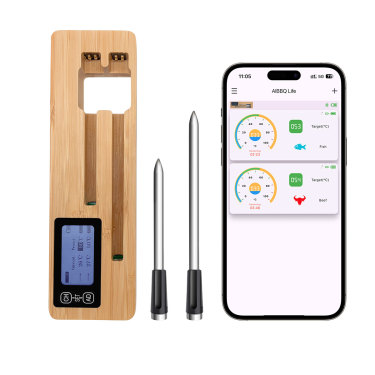
# Digital Meat Thermometer: The Essential Tool for Perfect Cooking
## Why Every Home Chef Needs a Digital Meat Thermometer
Cooking meat to perfection is both an art and a science. While experience and intuition play important roles, nothing beats the precision of a digital meat thermometer when it comes to ensuring food safety and achieving ideal doneness. Unlike traditional analog thermometers, digital versions provide instant, accurate readings that take the guesswork out of cooking.
## How Digital Meat Thermometers Work
Digital meat thermometers use electronic sensors to measure the internal temperature of food. Most models feature:
– A sharp probe that penetrates meat easily
– An LCD display that shows temperature readings
– Fast response times (typically 3-5 seconds)
– Temperature range suitable for all cooking methods
Advanced models may include additional features like programmable alarms, timers, and even wireless connectivity to your smartphone.
## Key Benefits Over Traditional Thermometers
Digital meat thermometers offer several advantages:
1. **Accuracy**: Digital models provide precise readings to within ±1°F (±0.5°C)
2. **Speed**: Get results in seconds rather than minutes
3. **Ease of Use**: Clear digital displays eliminate interpretation errors
4. **Versatility**: Suitable for grilling, roasting, baking, and deep frying
5. **Food Safety**: Ensures meats reach safe internal temperatures
## Choosing the Right Digital Meat Thermometer
When selecting a digital meat thermometer, consider these factors:
### Probe Type
– **Instant-read**: Quick measurements but not left in food during cooking
– **Leave-in**: Stays in food throughout cooking process
### Temperature Range
Look for a range that covers at least 32°F to 392°F (0°C to 200°C) for most cooking needs.
### Special Features
– Waterproof design for easy cleaning
– Backlit display for low-light conditions
– Magnetic attachment or clip for convenient storage
– Preset temperature settings for different meats
## Proper Usage Tips
To get the most accurate readings:
1. Insert the probe into the thickest part of the meat, avoiding bones and fat
2. For poultry, check both the breast and thigh areas
3. Clean the probe thoroughly after each use
4. Calibrate your thermometer periodically for accuracy
5. Allow the thermometer to stabilize before reading the temperature
## Recommended Internal Temperatures
Here are USDA-recommended safe minimum internal temperatures:
– Poultry (whole, pieces, or ground): 165°F (74°C)
Keyword: digital meat thermometer
– Ground meats (beef, pork, lamb): 160°F (71°C)
– Fresh beef, veal, lamb (steaks, roasts, chops): 145°F (63°C) with 3-minute rest
– Pork (chops, roasts, ribs): 145°F (63°C) with 3-minute rest
– Fish: 145°F (63°C) or until flesh is opaque
## Maintenance and Care
Proper care ensures longevity:
– Always clean the probe with warm, soapy water after use
– Avoid submerging the display unit in water unless specified as waterproof
– Store in a protective case to prevent damage to the probe
– Replace batteries as needed to maintain accuracy
## Top Digital Meat Thermometer Picks
While there are many quality options available, some consistently top-rated models include:
1. ThermoPro TP20 – Best for wireless monitoring
2. Lavatools Javelin PRO – Best instant-read for professionals
3. ThermoWorks ThermoPop – Best budget-friendly option
4. MEATER+ – Best smart thermometer with app connectivity
Investing in a quality digital meat thermometer is one of the smartest decisions a home cook can make. It takes the stress out of cooking meats, ensures food safety, and helps achieve perfect results every time. Whether
Comments are closed